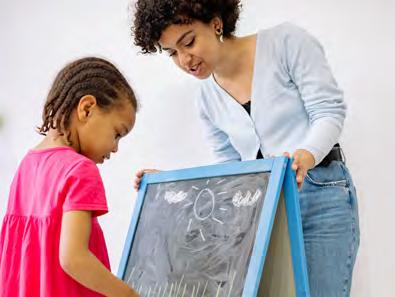
3 minute read
Youth Development
INCREASE AND CONNECT YOUTH TO OUT-OF-SCHOOL PROGRAMMING THAT REINFORCES AND ENHANCES LEARNING AND ENRICHMENT
Transforming Western builds on existing programs for youth and creates new programs to ensure that students have safe education and productive enrichment options. Over half of the target households have children and there are 150 children age 17 and under living in Western Heights target housing.
Advertisement
STRATEGY 1
Expand out-of-school learning opportunities for Western Heights children » Create teen-specific programming to engage at-risk youth » Increase evening hours to accommodate parent work schedules » Increase virtual and site-based academic tutoring opportunities » Provide afterschool pick-up transportation and door-to-door drop-off » Enhance STEAM curricula, technology skills classes, economic literacy, and self-esteem enrichment programming » Promote paid externships, apprenticeships, and opportunities for youth entrepreneurship » Enroll Western Heights mentees in career readiness programming » Sponsor on-site scouting troops » Expose youth to urban agriculture through farm apprenticeships » Offer high school youth test prep, job shadowing, and coping skills training opportunities
STRATEGY 2
Provide continued and expanded opportunities to explore interest in the arts » Create a youth arts program for K-12 youth that offers activities and skill development in the performing arts, visual arts, applied arts, and creative writing using hands-on tools and technology » Offer arts-focused community summer camp scholarships to Western Heights youth » Develop a youth outdoor garden at the
Western Heights Boys & Girls Club. Offer sitebased cooking classes and tasting sessions using grown produce and supply farm-fresh produce to families. » Expand performing arts programs to include dance and musical instruments » Give free music lessons and instruments for economically disadvantaged residents and neighborhood children » Have Artists in Residence provide classes on a sliding scale to the Western Heights residents
STRATEGY 3
Foster a sense of safety and well-being among youth » Build a dedicated children’s playground outside of the Western Heights Boys & Girls Club » Increase slots for youth/mentee matches for
Western Heights families » Create and support youth resident advisory councils for the Western Heights neighborhood
EXISTING CONDITIONS
60% of households with children report out-ofschool children’s programs as a most needed service 32% of households with children wish their children had access to the arts There are 103 youth ages 12-17 Living in Western Heights, 58% of which live in target housing. Youth focus group participants shared that they want teen-specific activities
23% of households with children wish their children had better access to technology/ computer classes 100% of households with children have access to technology and skills training 100% of children and youth have access to STEAM programming
TARGET METRICS
100% of target youth are involved in some outof-school programming
100% of target youth have access to arts programming 100% of youth in target housing are offered youth leadership, extern, apprenticeship, or employment opportunities Out-of-school programming enrollment for youth ages 12—17 increase by 50% Youth mentee matches increase by 50%
PARTNERS
• Big Brothers Big Sisters East Tennessee • Boys & Girls Club of the Tennessee Valley • Boy Scouts of America Great Smoky
Mountain Council • CAC Neighborhood Center, Tutoring • CAC Beardsley Farm • City of Knoxville • Emerald Youth, Calling and Career • Girls Incorporated Tennessee Valley • Girl Scouts of the Tennessee Valley • Girl Talk Inc. • Knoxville Leadership Foundation,
KnoxWorks • Tennessee College of Applied Technology • Wesley House Community Center • YWCA Knoxville and the Tennessee
Valley’s GameChangers and Supporting
Youth Experiencing Trauma (SYET)
OUTCOMES
• Children develop a larger network of community to support their sense of belonging and positive view of the future • Children are better prepared for college and/or the workforce • Children are better able to navigate risk-taking and gain enhanced protective factors








